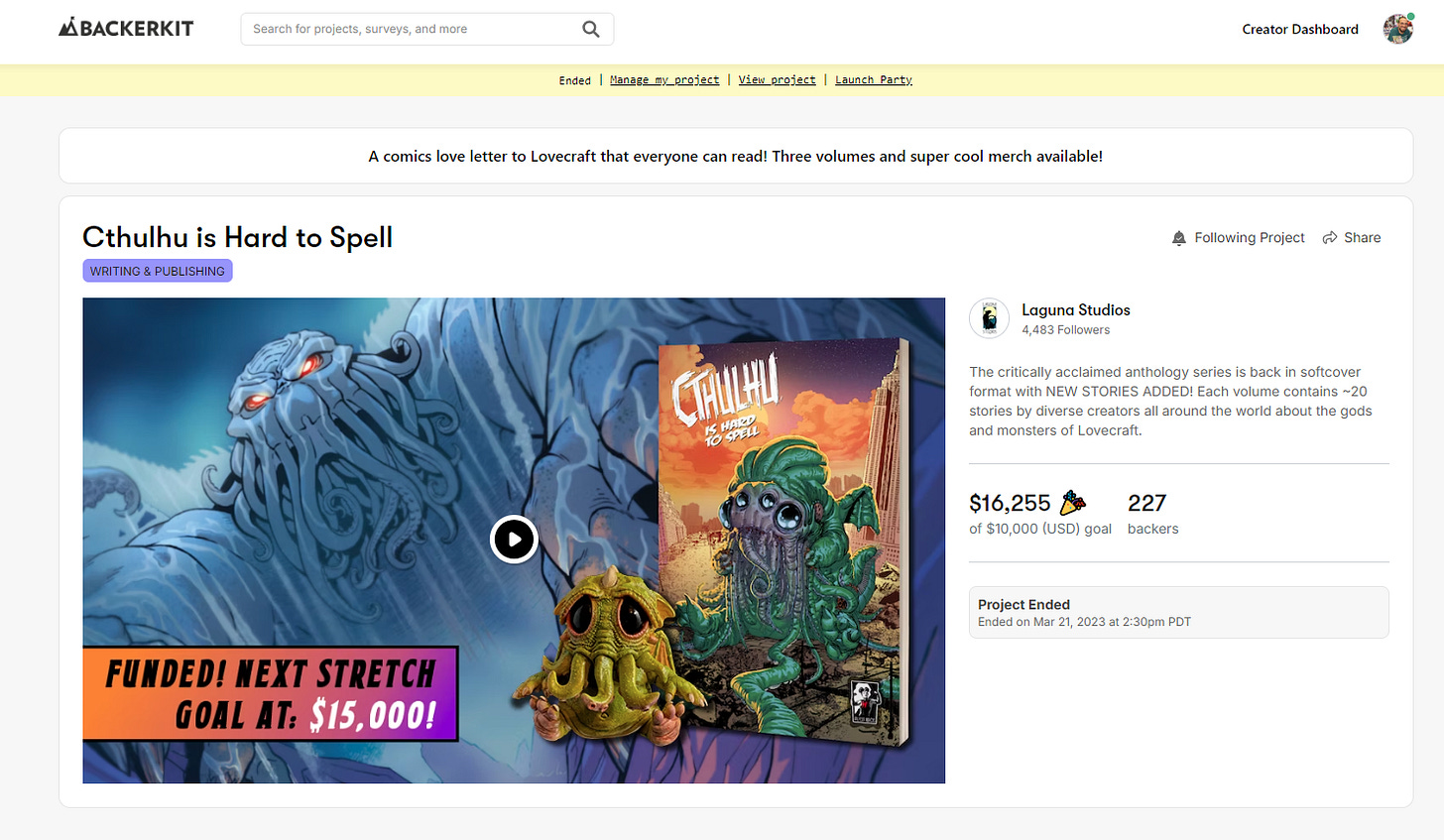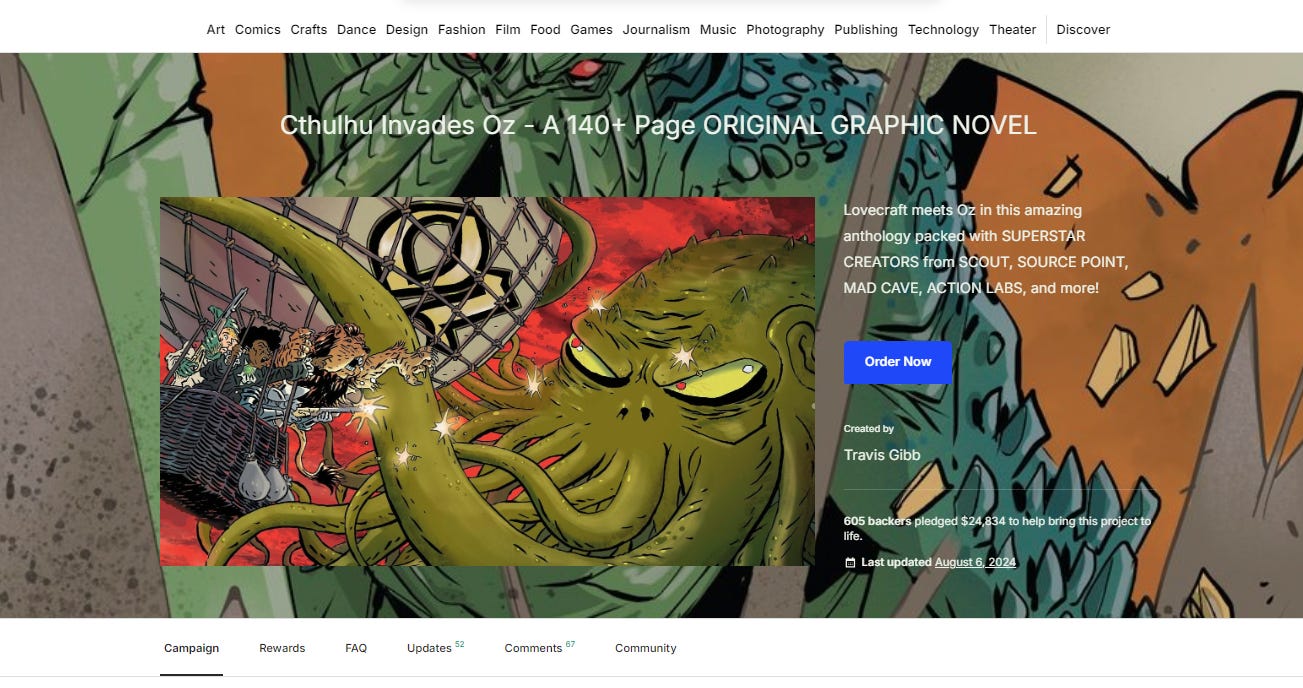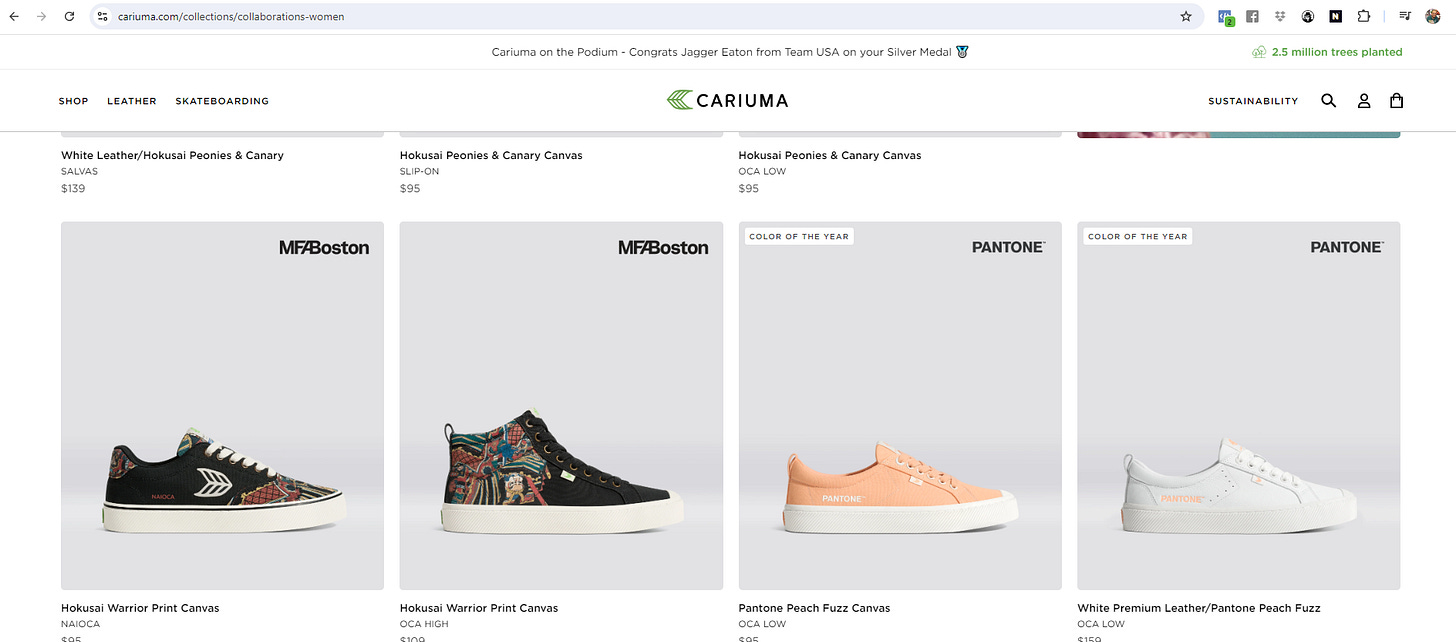How to form strong strategic partnerships in publishing
My motto is "do cool things with cool people" but what does that mean in practice?
Hi friends,
Since I started working in publishing, my motto has been “Make cool things with cool people”. I figured that if I kept doing that for long enough, the rest would work itself out. Of course, it’s a little more complicated than that.
I believe one of my strengths is forming strategic partnerships. I've worked with a lot of amazing people recently. What you might not know, though, is for the first several years of my career, I couldn't even get accepted into an anthology with a one-page story.
So, what changed? Well, I’m gonna tell you. Before we get started, you have to understand that my whole marketing strategy revolves around the idea of the Dream 100.
The Dream 100 is a strategic marketing approach designed to help businesses and individuals identify and target their top 100 ideal clients, partners, or influencers who can significantly impact their growth and success.
Following the complete methodology is exhausting, involves designing touchpoints, sending gifts, and getting increasingly salesy until I want to wretch, but there is a core of good in there, which is that if you have the right 100 people in your network, you can rule the world.
So, since the beginning of my career, I’ve been focused on meeting the coolest people in any room I’m in, especially if they are smarter than me. I am constantly inspired by the people I hang around and they push me further and further.
I do also want to note before I get started with this that at my core, I don’t expect anything from anyone except possibly friendship. Sometimes those friendships blossom into a cool thing down the line, but that’s not the intention. I just really want to meet and hang out with cool people who are making cool things.
Okay, so here is everything I learned about strategic partnerships.
*** Please note that if you are reading this via email, Substack only sent out a partial version and the article will eventually stop without notice. If you want to read the whole 3,500-word article, then go to this website or download the app.***
1. Do something really, really, really well
I've been lucky to go deep on several niches, platforms, and formats my career, and done many of them well.
I had a 200-episode podcast and another 100 episode podcast before working with
on The Six Figure Author Experiment.I had released two books, hundreds of articles, and multiple courses on authorship before partnering with
.I'd released over 1,000 pages of comics before working with SK Prince on Death’s Kiss.
I built up a Substack to 30,000 subscribers and 500 paying members (and had cowritten several other successful books) before working with
on How to Build a World-Class Substack.Even though not all my previous ventures were super successful, there was a level of quality to all of them and an understanding of how to make them successful that went into each one. It has to be good enough that somebody can say "I want that, too" when they look at it.
We have a bunch of resources behind the paywall to help you get to that next level and make world class material.
2. Have an audience that you're collaborator wants to get in front of with their stuff
You don't necessarily have to have an audience, but the bigger audience you have that is complementary but not overlapping to somebody else's audience, the more somebody will be interested in working with you. I call this a “dimilar” audience, because it’s different but similar.
Even though Monica and I had similar styles in some ways, we had completely different authors and creators in our audience. I worked mostly with comic creators and she worked with authors. So, together we were able to double our audience with one book.
If you have a smaller audience, but you're great at writing to market, that is a bit different. You could get pretty far with almost no audience if you can go viral on command. People highly value that talent, especially if they already have an audience, because now they can supercharge your magic.
However, there is no doubt the more powerful the audience, the more interest you'll get, especially if you have some weird platform expertise like Kickstarter or Substack or something like that which your partner is eager to exploit. There is no doubt that the fact my Substack is about to crest 40,000 subscribers influences whether people take me seriously or not.
Building the right audience is going to be enormously helpful in getting yeses from collaborators. The level of my collaborations has grown in tandem with the level of my audience.
3. Be cool for a while
Aside from Lee, who I basically started working with a week after meeting, every other person I've collaborated with at a high level I've known for a long time.
Remember, your partner is going to be vouching for you with their audience and devoting a lot of time to launching something with you, so you need to be cool. I was able to short circuit that with Lee because I literally owned the conference I met her at, and she was brought in by one of our conference directors, Tawdra Kandle, who has a stellar reputation.

Also, to be frank, I'm probably no longer on the come-up. I've done enough things with enough people at a high enough level that my path to yes is a lot shorter these days then when I started. I have been in talks with a brand I met in June for a very large partnership and I closed that with a 6 minute call, but that is only because I had a proven track record and the audience to back it up.
Once you’ve built up a network and reputation, you can do a lot more with a lot less effort.
When I started, it would take 1-2 years to build a relationship with somebody before we worked together. Then, another 1-2 years for the collaboration to bear fruit. Yes, it takes that long. If you want collabs for 2025, you probably needed to plant the seed for them in 2023. Maybe you can still set one up, but everyone I know sets up their year at least a year in advance, especially with collaborations.
Did you know that you could back Claire and my book about Substack on Kickstarter right now. You’re here, on Substack, reading about being better at marketing, and we have a book that can help you for as little as $10.
4. You had better actually be an expert if you say you are one
With each partnership that worked, I was an expert in whatever I pitched them. I know how to put together a book, but I also know editors and a network to get it in front of the right people, and make sure it's not embarrassing without them having to work on it.
With Death's Kiss, I introduced SK Prince to our publisher. In fact, they reached out to me after reading it and asking if we would sign with them. Laurie Foster and I have worked together for years before on multiple projects, including Cthulhu is Hard to Spell, that had performed well for us.
I also knew this was the kind of thing she was looking for (and I kind of made it in a way that might interest her). So, doing more things made sense.
When it came to the podcast with Lee, she told us "If I can just show up and talk, I'm in". Since we already had a network of editors, VAs, and a had another podcast, we could get that up and running no problem. It's not getting the views we want yet, but I think we've delivered on that. We show up, it gets edited. It looks good. We have fun.
With the Death’s Kiss comic, SK Prince really wanted to get into comics and I knew that world, so I basically walked her through the process and handed her a script that was pretty much ready for an artist.
I set up the art team and then translated her concerns to the artist. At every opportunity, I showed her the best people in my network, my dream artists who would put me in the best possible light. We ended up with an exceptional story that ended up being my second highest-backed campaign of all time.
5. Go slow
Most collaborations build over time. With Hospice, I had been in several of Travis Gibb’s anthologies, and he had been in several of mine, so we had a vibe.

Even with SK Prince, I asked if we could do a one-shot, single issue story to test whether we wanted to work together or not. Before signing the contract with Laurie for Cthulhu is Hard to Spell, I was in her anthology series Elsewhere which showed me how she ran her anthologies was closely aligned to how I ran mine.
6. Put yourself in a position to win
Really, it's about meeting the right people, and knowing the right people takes time. I've been doing this since 2010, meeting people, building up my Rolodex filled with heavy hitters. I grew up with a lot of them in this business. Then, when the right opportunity came along, we decided to work together.
With Travis and the Hospice crew, I'd been making horror-adjacent comics for years before he asked me to work on that project, and also knew I was willing to try weird things to see if they work. I was a fan of all the other creators and (hopefully) they were fans of mine as well.
I call this planned serendipity, which is all about getting the right mix of people together and knowing that something good will come from it, even if you don’t know what that thing will be exactly.
Aside from Lee, who I only became a huge fan of after meeting her, I was an enormous fan of every single one of my partners as both humans and creators well before we worked together. Even with Lee, I heard her speak at my conference, and had a meeting where we vibed immediately. So, it was easy. We basically just get together and hit record.
7. Step out of your niche
Once you have yourself together, it's time to step out of what you do to find people to work with, because everyone you know already knows the things you know.
If you look at a company like Cariuma, they are always bringing in collaborators for their shoe brands, but they are never other shoe companies.
They are podcasters and artists and influencers. This allows new audiences to be exposed to their brand, but be warned. They are only being so broad because everyone needs shoes.
Only court partnerships with audiences that need what you have to sell.
SK Prince was a good example of this with Death’s Kiss. Even though I had never done a romance comic before and she had never done a comic before, I knew the market loved NSFW comics. Since it was a paranormal romance book to boot, I knew my audience loved fantasy books and that the market for romance comics had been growing exponentially in recent years. When we brought on Laurie as our publisher, who already had a burgeoning NSFW audience, and Yishan Li who drew many successful NSFW comics, it made was easy to see the market fit in working together.
Most of the work I do these days is in translating from one format to another. So, with Lee I took a lot of her non-fiction energy and we turned it into a podcast. With SK, we translated a book into a comic. With Monica, we were translating the strategies that work in comics on Kickstarter for a prose audience.
With Claire, we're bringing our Substack expertise to authors. Yes, we hope to capture both audience, but unless you work with publishers in your niche, probably nobody is going to hire you to do the job they already do and like.
With
and Alice Briggs, we worked together to create a magazine issue around a lot of our methodology and thinking that had already been successful, but never had it in magazine form for Indie Author Magazine.One of the best things I learned was that my skills are hella valuable...they just aren't valuable hanging around people who have the same skillset as me.
8. Have a vision
With all these partnerships, I had a very clear vision for what I wanted and could articulate it. Except for SK Prince, that started from a general meeting, all these collaborations were very focused.
With the Substack book, I knew I wanted to work with Claire, and I told her exactly why. With the podcast, it was the one major thing I wanted to get clarity on, and when I met Lee she vibed with it. I didn't pitch 10 things. I pitched one thing.
9. Do the work
My first collaboration with Monica was on a book that I'd already largely written, at least insomuch as I had a course about it. With SK, I delivered a script about a week after getting the story even without a contract. I wanted to show the work before they came on board.
With Laurie, I already had the books, and sales numbers, and all she had to do was say yes and then do her work. Now that we've done a lot of work on it, we are gonna do a new one, but we've been working together for almost two years now just on the stuff I already had produced.
It's important to note here that I would have, and did, do handshake agreements with all these people. As Lee told me once, if you're not willing to do a handshake deal with them, you shouldn't work with them, and I think that's right.
10. It might not work out
Even if you do everything right, it might not work out. We didn’t sell out our mastermind the first year, and we probably won’t this year, either. One Damned Good Thing barely broke even, making me only $11 in profit at the end of the day.
The Six Figure Author Experiment isn’t where we thought it would be with downloads after 10 episodes. Some of the books I co-write with Monica were flops.
I’ve also had collaborations blow up in my face. Those are the ones I never talk about with anyone. I just file them away and move on without getting public about it. Everyone loves messy drama, except for people who are highly successful. They want things to be easy and clean. If you prove you’re a drama llama you are hurting your chances to work with them.
Successful people want to know you can keep your mouth shut and not damage their brand, even if things go to pot.
Still, I wouldn’t call any of them failures. At the worst case, we got a product that I’m proud of at the end…and with some of them it’s too early to tell. We’re still selling this conference, and just beginning this podcast, for instance. I find that you can’t know how you feel about something until it’s over.
All you can do is make a product we’re really proud of and enjoy the experience. I started my career saying that I hoped when their careers are done, my collaborators would look back at our project as one of their favorites from their career. I still believe that in my very bones. If you put out work that you care about, and make projects that brings everyone, even the creators, joy, good things happen.
By the way, this goes both ways. When I was looking for an editor for Cthulhu is Hard to Spell,
was my first, and only call, because I knew she did the work, we got along well, and I enjoyed how she thought about the world. Still, I worked on my pitch for several days before getting in touch with her, but she unlocked a whole different level of creators to us.With Mel Jolly and Tawdra Kandle, Monica and I had been to multiple conferences they managed before we hired them to run our conference.
I used to be more focused on budget, but now my only questions are about whether this person is world-class in what they do and whether our audiences complement each other.
I've been very lucky, blessed even, to have such incredible collaborators, but I've always had intention with how I moved through the world and built my network. That's why I like Facebook so much, because it's this little powerful network that just gets more powerful as we go about our lives.
BONUS: Don’t sign a contract with anyone you wouldn’t work with on a handshake deal
There are a lot of scammy people who will take advantage of you out there, which is why it’s so important to properly vet your collaborators, but Lee said something when we first started working together that really stuck with me.
I wouldn’t sign a contract with anyone I wouldn’t work with on a handshake deal.
Contracts are essential to spell out the bounds of the partnership and make sure all parties are on the same page, but they are a pain to enforce. I’ve worked for clients for years and never signed a contract with them. I don’t recommend that, by the way, but by the time we got around to the contract we already had plenty of chances to stab each other in the back and didn’t.
That’s the vibe you’re really looking for in a good partnership. If you wouldn’t work with them on a handshake deal, don’t sign a contract with them.
That said, I have felt that way and then seen the contract and not signed it because it was ludacrous, but if you don’t trust the person to act with integrity, don’t work with them.
If you don’t believe they are working in good faith, then you will take every little thing that goes wrong as a sign they are trying to screw you. Now, some people will be trying to screw you, but good partners mess up too. The difference is that they’ll try everything in their power to fix the issue and be fair with you.
I just had a conversation with a partner who was doing something I took the wrong way, but it ended up being a misunderstanding. They just hadn’t gotten around to sending me the contract details yet for a new project, and when they did, I signed on to them because they were fair and equitable.
Good partnerships will be deeper and longer than you can possibly understand when you start doing them, and you’ll always carry them with you even after they are done.
What do you think?
Does the Dream 100 resonate with you? Have you already tried it? To me it’s the easiest marketing strategy to keep up with because it’s mostly about hanging out with cool people, which is one of my only goals in life anyway.
Let us know in the comments.
If you saw value here, I hope you’ll consider becoming a paid member to help foster more of this type of thing. As a member, you’ll get access to over 850 exclusive posts, including books, courses, lessons, lectures, fiction books, and more, or you can give us a one-time tip to show your support.
Where to go next:

\



























These are great tips! Thank you for also highlighting the failures. We often forget that behind all major successes are many flops!